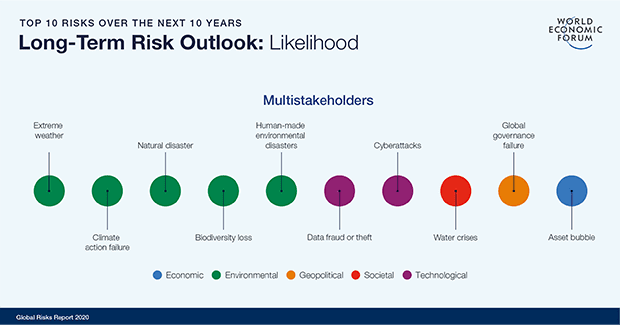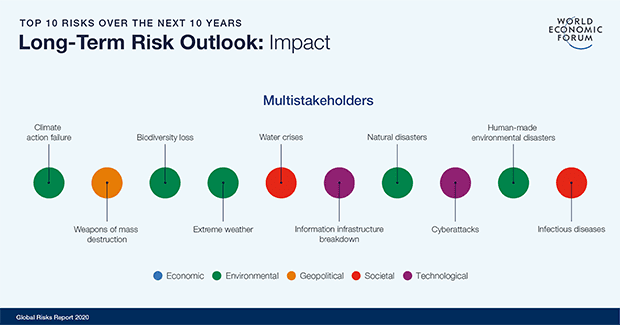Environmental Concerns Dominate Global Risks List
For the first time in the 15-year history of the World Economic Forum’s Global Risks Report, environmental perils filled the top five positions on the list of long-term risks in terms of likelihood of occurrence over the next 10 years.
The report, which is a qualitative and quantitative study of global risks, conducted in partnership with members of the business, academic, and public-sector communities, is intended to bring stakeholders together in developing sustainable, integrated solutions to the world’s most pressing challenges. It was produced with the help of strategic partners, Marsh & McLennan and the Zurich Insurance Group, and academic advisers from the National University of Singapore, Oxford Martin School of the University of Oxford, and Wharton Risk Management and Decision Processes Center at the University of Pennsylvania.
“The global risk picture is worrisome,” Børge Brende, president of the World Economic Forum, said during a panel session held days before the group’s 50th annual meeting convened in Davos-Klosters, Switzerland, this week. Brende noted that risks are increasing. “The last five years have been the hottest ever on our planet,” he said. “We have to take this really, really serious[ly], and we have to change our approach. The cost of inaction today far exceeds the cost of action. That’s why we now have to start to implement the necessary policies to deal with climate change,” Brende said.
Extreme weather has filled the top position on the list of risks for the past four years. Rounding out the top five in 2020 are climate action failure, natural disasters, biodiversity loss, and human-made environmental disasters (Figure 1). The environmental concerns exceeded threats in other categories that included technological risks, such as cyberattacks; societal risks, such as water crises; geopolitical risks, such as weapons of mass destruction; and economic risks, such as asset bubbles.
 |
| 1. Long-term risk outlook ranked left to right by likelihood. Source: World Economic Forum 2007–2020, Global Risks Report |
The report is based on the World Economic Forum’s annual Global Risks Perception Survey, completed by approximately 800 members of the Forum’s diverse communities. “I am particularly proud that for the first time we are also featuring the results from more than 200 members of our Global Shapers Community—a generation of emerging global social entrepreneurs and leaders,” Brende wrote in the report’s preface. “This younger generation is increasingly using its digital savviness—and its feet—to spotlight issues, particularly relating to climate change, that it sees as existential risks not only to its generation but to the wider global community.”
When risks are ranked based on impacts, however, the top five risks change (Figure 2). Climate action failure rises to the top, followed by weapons of mass destruction, biodiversity loss, extreme weather, and water crises. In light of the recent coronavirus outbreak in China, which has forced the country to lock down the city of Wuhan, a major travel hub and home to more than 11 million people, it’s notable that the risk of infectious diseases ranked 10th on the list in terms of impact.
 |
| 2. Long-term risk outlook ranked left to right by impact. Source: World Economic Forum 2007–2020, Global Risks Report |
Still, climate-related issues dominated the report. “In late 2019, UN Secretary-General António Guterres warned that a ‘point of no-return’ on climate change is ‘in sight and hurtling toward us.’ Respondents to the Forum’s Global Risks Perception Survey also are sounding the alarm,” the report says.
“The good news is that the window for action is still open, if not for much longer. And, despite global divisions, we continue to see members of the business community signal their commitment to looking beyond their balance sheets and towards the urgent priorities ahead,” Brende wrote.
—Aaron Larson is POWER’s executive editor (@AaronL_Power, @POWERmagazine).